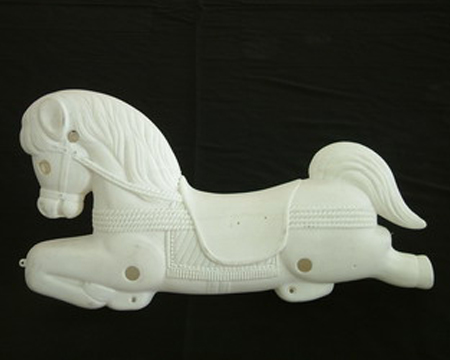


The blow molding process can be divided into four phases:
(1) During the parison formation stage, the transport, melting, mixing and pumping of the polymer in the extruder are the formation stages of the parison; at this stage, the main process parameters affecting the wall thickness distribution are:
1 material molecular weight distribution, average molecular weight;
2 Blowing machine temperature control system and screw speed, wherein the temperature control system includes hopper temperature, barrel 1 zone, zone 2, zone 3, zone 4 temperature, flange temperature, and storage die;
(2) The parison blanking stage is extruded from the gap between the lip and the core into the blanking stage. At this time, the two phenomena of the parison release expansion and the parison vertical extension affect the parison molding. The main process parameters affecting the wall thickness distribution are the die diameter and wall thickness control system of the blow molding machine, wherein the control system includes an axial wall thickness control system and a circumferential wall thickness control system to adjust the gap between the die lip and the core.
(3)
The parison pre-blowing stage is to pre-inflate the parison in order to
avoid the contact and adhesion of the inner surface of the parison and
improve the uniformity of the wall thickness of the product. In the
pre-blowing stage of the parison, the inside of the parison is jetted
into the parison to protect the parison and reduce its vertical
extension. At this stage, the main process parameters affecting the wall
thickness distribution are: pre-blowing pressure and pre-blowing time.
(4) High-pressure inflating parison in the high-pressure blowing stage of the parison, so as to be close to the mold cavity to realize the plastic molding stage of the product. At this stage, the influence of the product molding is that the parison is subjected to high pressure inflation and deformation, and the parison and the cavity are in contact with each other. The main process parameters affecting the wall thickness distribution are: material shrinkage rate; blowing pressure, time; mold material, structure, mold exhaust system and mold cooling system, such as cooling water channel distribution, cooling water inlet temperature. Although there are many factors affecting the quality of blow molded products, when the production conditions and product requirements are determined, adjusting the blow molding process parameters can effectively improve the quality of the products. Optimized process parameters can increase production efficiency, reduce raw material consumption, and optimize product performance.
Contact: Mr. Zhu
Mobile: 13506226747
Tel: 0512-56766606
Fax: 0512-56766608
Email: [email protected]
Address: No. 28 Guotai north Rd, Zhangjiagang, Jiangsu,China
Website: 11qc.cn